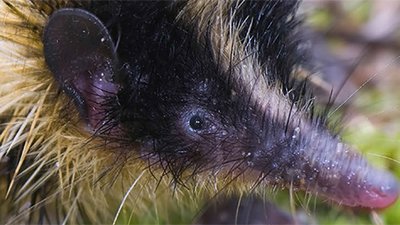
Which Came First: Egg-Laying or Live Bearing Mammals?
“Eggs-actly what evolved first, egg-laying or live-bearing mammals?” evolutionists ask.
News Source
- LiveScience: “Earliest Mammals May Have Been Egg-Layers After All”
Evolutionists aren’t joking when they ask, “What came first, the live-birth or the egg?” A recent review in Science, “Reproduction in Early Amniotes,” by paleobiologist P. Martin Sander suggests commonly held beliefs about this question might be in error. The question is important to the evolutionary tale of terrestrial conquest, as evolutionists hold that 50 million years after four-legged amphibians evolved, evolutionary changes in reproduction enabled amniotes—reptiles, birds, and mammals—to evolve.
Amniote embryos—whether in a shell or not—develop within a set of membranes. The eggs of fish and amphibians have no membrane wrappers, are typically jelly-like, and may be fertilized after they are laid. Evolutionists believe fish and amphibians evolved before amniotes.
The key innovation, Sander believes, had to be a move toward a shelled egg in order to fill the world’s diverse terrestrial habitats. The deeper layers in the fossil record preserve live-bearing reptiles and mammals without evidence of eggs, however. This has led some evolutionists to think amniotes first evolved as live-bearers.
On the other hand, evolutionists generally consider the egg-laying mode of reproduction to be more primitive than live-bearing. Some reptiles retain their eggs internally until they are fully developed and give birth to live young. Therefore, according to Sander, “Observations on lizards show that live bearing evolves readily from egg laying (by embryo retention) but not the other way around.”1
If egg-laying really is more primitive, then where are all the early egg-laying mammals?
Since the fossil record doesn’t seem to support what evolutionists generally consider the sensible order of development, Sander in his review tries to answer the question, “If egg-laying really is more primitive, then where are all the early egg-laying mammals?” He concludes that during the evolution of the egg, the membranes in which amniote embryos are wrapped had to evolve long before the calcified shell. Therefore, he believes leathery-shelled eggs, which would not have easily fossilized, must have been prevalent in primitive amniotes, including mammals. Then 90 million years later, by the time calcified shells evolved, he maintains, mammals and other amniotes had diversified and filled the world’s habitats.
Most mammals, of course, do not lay eggs. Sander is suggesting that since egg-laying seems more primitive, early mammals must have laid eggs even though there is no actual evidence for it. He concludes that the earliest mammals to evolve must therefore have laid leathery soft-shelled eggs that would not be expected to fossilize well. He advises a diligent search for “fossils of early amniote embryos and eggs”2 in order to put the pieces together and elucidate the evolutionary history of amniotes. “These eggs are probably out there,” Sander says, “but nobody has looked hard enough for them or they have not been recognized.”
Evolutionists see the more elaborate egg—one with protective membranes and a soft shell—as an evolutionary advance. The calcified shell in their view is an additional advance. And since organisms with such an egg—amniotes—are able to reproduce outside of water—unlike amphibians with their exposed jelly-like eggs—evolutionists believe egg evolution enabled land animals to evolve. (Remember, they also believe the marine mammals represent a return to the water later in the evolutionary saga.) Furthermore, they believe increasingly complex behavior had to evolve along with the shelled egg, as fertilization must take place before the eggs are laid.
What is the proof that any of this is true? There is none. There is no proof that either scenario actually happened. The author in this article debates the order in which evolution happened because the actual evidence doesn’t really fit either. The evidence is, however, consistent with biblical history. The Bible records the creation of all kinds of animals during the same week about 6,000 years ago. Those animals reproduced after their kinds using a variety of methods. Much of the fossil record reflects the order of burial in the rising turbulent waters of the global Flood. None of the fossil record represents the order in which animals evolved because they didn’t evolve. Hence, the fossil record of the evolution of early mammalian egg-layers is missing because, well, they didn’t evolve.
Egg variety does not demonstrate evolutionary ascent but just different kinds of eggs suitable for different habitats and lifestyles. Common designs using membranes wrapped around embryos were suitable for a number of different amniotes, those with soft shells, those with calcified shells, and those with no shells. And the unshelled jelly-like eggs of amphibians and fish are suitable for their lives, not proof they represent a primitive less evolved form. It’s not evolution, just eggs.
Further Reading
For More Information: Get Answers
Remember, if you see a news story that might merit some attention, let us know about it! (Note: if the story originates from the Associated Press, FOX News, MSNBC, the New York Times, or another major national media outlet, we will most likely have already heard about it.) And thanks to all of our readers who have submitted great news tips to us. If you didn’t catch all the latest News to Know, why not take a look to see what you’ve missed?
(Please note that links will take you directly to the source. Answers in Genesis is not responsible for content on the websites to which we refer. For more information, please see our Privacy Policy.)
Footnotes
- P. Martin Sander, “Reproduction in Early Amniotes,” Science 337: 806–808 (17 August 2012).
- Ibid.
Recommended Resources

Answers in Genesis is an apologetics ministry, dedicated to helping Christians defend their faith and proclaim the good news of Jesus Christ.
- Customer Service 800.778.3390
- © 2024 Answers in Genesis





